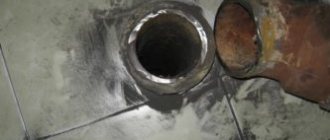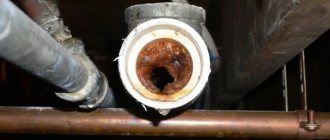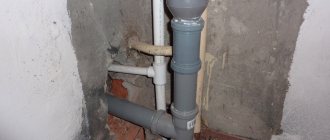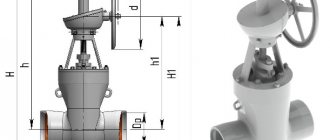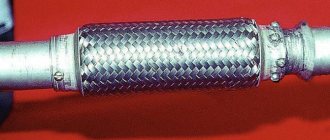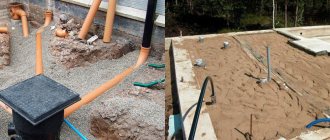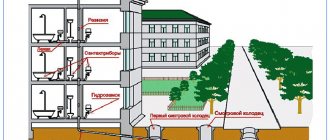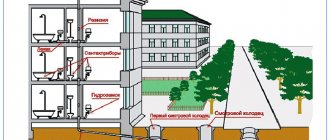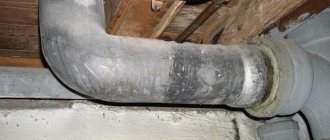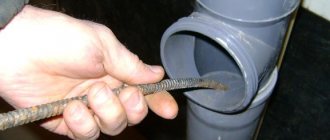The most difficult step when replacing an old pipeline is the dismantling of a cast iron pipe that has served its purpose. Previously, when constructing communications, pipes made of cast iron were used, the connection of which was made with cement mortar, sulfur or aluminum. Pipelines assembled using the last two substances are very difficult to destroy, so you need to prepare for lengthy dismantling work. And this article will tell you about the technology for their implementation.
Laying a new sewer often begins with dismantling the old one
Repair work on the street
If there is a need to repair a cast iron pipe that is located on the street, then you can use the same methods as described above.
However, it is advisable to do additional fixation of the joined cast iron pipes so that deformations in the ground do not open cracks. If the pipe is adjacent to a septic tank, then the above methods may not work. The design of the septic tank is subject to seasonal fluctuations, and this can destroy the integrity of the connection being repaired. In this case, the first step is to use liquid glass, which is filled on top in large quantities with mastic, which is used for gluing joints in panel houses. In principle, mastic perfectly seals cracks on its own, so if liquid glass is not available, you can do without it. However, it is still better to do sealing with it, it is more reliable.
When renovating, many people try to replace all outdated communications at once. It turns out that the most difficult thing to work with is cast iron sewer pipes that need to be dismantled. Previously, they were connected using cement, sulfur or aluminum. It turns out that the system was carried out for centuries. But now the end of the century has come. And at the same time, difficult work begins.
At first glance, it may seem that removing cast iron pipes is very easy. But here you need to work wisely. After all, if you apply too much force, you can damage the riser that connects several apartments at once. In this case, the anger of the neighbors is inevitable. There will be costs, time and a lot of work.
Before you start dismantling an old cast iron pipe, you need to familiarize yourself with some rules:
- turn off the water supply in the house;
- remove the hose from the flush tank on the toilet;
- clean the toilet carefully;
- remove from the premises all devices and objects that may interfere with the work;
- Cast iron is a brittle material. Pipes that are located far from the riser can be broken with a hammer;
- removal of pipes that directly approach the riser;
- Cuffs are installed on the bell. First, the bell is cleaned of lubricants.
Preventing blockages
To ensure that the sewer system does not cause you problems, you need to follow a few simple rules. Make sure all drains have screens to filter out contaminants from the water. Do not throw rags, food waste or grease-containing waste down the drain. It's better to use a trash can. When cleaning, pour boiling water over the drain holes. Flush the drains at least twice a year with chemical compounds to prevent blockages.
Follow the rules:
- The toilet is designed for one purpose only. Use a trash can to dispose of leftover food and various debris;
- When pouring out water after cleaning the apartment, check whether you left a rag in the bucket;
- There must be nets on the drain holes of bathtubs and sinks;
- Wash dishes only with hot water; statistics show that the maximum number of local blockages occurs in the summer, after the temperature of the water in the hot water supply decreases to 40-45 degrees.
Dismantling instructions
It is best to begin work on dismantling pipes that are located remotely from the riser. Here a hammer and chisel will help get the job done very quickly, since cast iron is a material that is brittle and cannot withstand impacts.
It is important to use a rubber hammer or with a polymer tip. A steel hammer will crush the cast iron into small pieces that can fall into the riser
Further, a congestion will begin to form there, which will be very difficult to eliminate.
Work with a hammer and chisel continues until it reaches the tee that leads to the riser. Then you can try to loosen the crosspiece manually. But you can leave the cross section completely. However, experts recommend removing cast iron from your home as much as possible.
The work of heating the pipes is carried out quickly by two people. One person can heat the pipes with a lamp, and another can remove the softened sulfur with a knife. When a large amount of sulfur has been removed from the pipes, the cross will quietly separate from the riser. If you cannot completely pull out the tee, you can cut it off with a grinder. The main thing is not to damage the riser.
Effective cleaning methods
The blockage requires prompt removal. Cleaning water pipes from the inside at home is usually not difficult. Cold and hot water lines need to be flushed periodically. Most often, plaque appears in the following areas:
- Filters - meshes for catching large particles are installed at the entrance to the apartment, in front of meters and mixers. Depending on the quality of the liquid, they clog at different rates. The filters are easy to clean by simply rinsing them with water. Complex deposits and rust are removed with an acid solution.
- Bent sections of pipes where foreign matter settles.
- Taps and mixers - layers appear on the internal parts of the structure.
- Joints – rust particles or sand cling to rough surfaces.
Lime deposits on the elements of the hot water supply system lead to a drop in the temperature of the coolant. Energy consumption for heating increases. Lime deposits are extremely hard and difficult to remove. Hot water pipes are cleaned using chemicals and mechanical devices. He considers the most effective effects on plaque to be ultrasound and electromagnetic waves.
Cleaning methods vary in speed and effectiveness. They are selected based on the degree and nature of the blockage.
Mechanical
Build-ups and blockages inside pipes are removed using mechanical devices. One of them is a plumbing cable. The device is made of metal wire and has a handle for rotation. It is used to clean water pipes from stones, sand, and lime deposits. The device nozzle is selected according to the diameter of the line. Before starting work, turn off the water. Access to the inside of the pipeline is carried out through a removed tap. The cable is advanced with rotational movements. The removed layers are washed after opening the valves. You can make the device yourself. You will need flexible, strong wire. A loop is constructed at one end, and a handle for rotation at the other.
An easy way to remove rust from water pipes is to tap them with a hammer. Before tapping, open the tap completely. The oxide will leave the system with the flow of water. Impacts must be careful not to damage the metal.
Chemical
Hard lime deposits from hard water are dissolved with acid. Acetic or citric acid is used in everyday life. Sediment on water pipes is removed with special cleaning products. They are sold in hardware stores. The drug is poured into the system, blocking access to household appliances. The solution is left for 1-2 hours, according to the instructions for use. Then the pipeline is washed with water by opening the taps. To protect yourself from chemical residues, you need to drain the water for 30-40 minutes. The method is costly and risky. When choosing chemical reagents, the material of the pipes is taken into account. Strong acid (hydrochloric, phosphoric acid) can corrode plastic
When working with chemicals, it is important to follow safety precautions
Ultrasound
Ultrasonic waves have a destructive effect on any deposits. They remove scale more effectively than chemical reagents. Under the influence of devices, re-deposition of calcium salts is prevented. Ultrasound causes structural changes in chemical compounds in a liquid.
How to dismantle a cast iron pipe
If a pipe is “welded” to a wall or floor using sulfur or aluminum, it will be very, very difficult to destroy such a coating.
To get started, you must first turn off the water supply to the apartment. Then you need to free the bathroom from unnecessary items that you can damage during work. This includes the sink, washing machine, laundry basket, etc.
Next, you need to disconnect the flush tank from the water supply and dismantle the toilet itself. Problems may also arise here, since Soviet toilets were screwed to the floor conscientiously, in other words, tightly.
Try to unscrew the bolts that attach the toilet to the floor and remove it from its place. If you succeed, consider yourself half done.
Now comes the turn of the pipes themselves. Cast iron, as you know, is not particularly strong, so at some distance from the riser you can simply break the old pipe with a hammer. It is much more difficult to remove the remains of pipes from the old riser and clean them before installing new ones.
To dismantle pipes, you may need:
- A hammer with a rubber or plastic tip.
- Chisel
- Torch or blowtorch
- Mask
Quite a strange combination, isn't it? However, a gas mask is necessary to comply with safety precautions if the joints of sewer pipes in your bathroom are filled with sulfur.
The easiest way to remove sulfur is by heating it. However, when heated, the sulfur mass releases toxic substances into the air, which are extremely harmful for humans to inhale. That is why it is better to protect yourself with a gas mask in advance.
So, dismantling must begin at the point of greatest distance from the riser. Here, most craftsmen do not bother with the torch, but simply break the pipe with a hammer. This is much simpler, but can cause some complications.
Make sure that when broken, pieces of pipe do not fall into the sewer passage. They can cause serious clogs in the drain, which will be much more difficult to get rid of than getting rid of old pipes.
With a hammer, you can destroy the pipe up to the crosspiece inserted into the riser. Here it is somewhat different and filled with much more sulfur.
To free the pipe and cross from the layer of sulfur, you need to heat it. The impact of a burner or blowtorch can last for several hours, while harmful substances will be constantly released.
Before you start heating, isolate animals and household members, cover furniture or other furnishings located in the immediate vicinity of the riser, and put on a gas mask.
During the heating process, you can easily chip off pieces of sulfur until the pipe is sufficiently clean. Now, the cross inserted into the riser must be loosened if possible and removed from the riser.
The dismantling of the old pipeline is carried out as much as possible. That is, all possible pipes are removed, and others are installed in their place.
Connecting a new PVC pipe to an old cast iron riser will require certain operating skills. Please note that you must clean the connection area as much as possible from the same sulfur and rust.
To make the job easier, use a special coupling that is specifically designed to connect cast iron pipe and PVC pipe.
If you still have questions, take a look at ours and ask them there. Our experts will help you understand the intricacies of good construction and renovation.
The best store products
There are compositions on sale for removing rust from both the inside and outside of the pipe. Top 3 effective remedies:
- Prosept. Concentrated thick product for removing rust from the inner surface of pipes. One cleaning will require 350 ml of gel. Exposure time – 2 hours. Price for 1 liter – 158 rubles.
- Chistin gel. The product is used to remove rust and blockages in pipes. The gel is poured into the sewer in an amount of 250 ml, left for 15 minutes, and washed with a powerful stream of water. The cost of 0.5 l is 45 rubles.
- Converter with Zinc Fill Inn. This product can cope with a layer of rust up to 100 microns thick. It can be used to process the outer surface of cast iron, steel and other metal pipes. The cost of a 0.4 liter package is 164 rubles.
The process of dismantling pipes connected by cement and cable
When discussing how to dismantle an old cast iron sewer connected with cement, it is worth noting that the process is not much different from the above, but is safer.
This is explained by the fact that sulfur releases carbon monoxide during melting.
And it all starts with cutting off a certain part of the cast iron pipe, for which you need to step back from the disconnection points by about 30 cm.
The hardened cement is knocked down using a hammer, which needs to be hit on a screwdriver inserted into the hole.
Dismantling the connection with cement and cable
It is important to know that you should not rush in this matter, because you may damage the bell. After breaking the cement at the joints:
After breaking the cement at the joints:
- you should try to loosen the main pipe. If you are interested in how to disassemble a cast-iron sewer without heating, then know that it is possible to remove the heel;
- If you can’t loosen the pipe even without a heel, then strong heat or a special wrench will help. For example, for pipes with a diameter of 50 mm you need tool No. 3, No. 4, but for a tee you will need another pipe.
Replacement of water and sewer pipes is usually necessary when the system is partially or completely worn out. And if you decide to carry out technical work without the participation of professionals, then you need to prepare in advance and know how to dismantle the sewer yourself.
Do-it-yourself repair work is dangerous because even when replacing a worn part, there is a possibility that the leak will reappear. As a result, if the sewer pipes are not trustworthy, it is better to completely change the entire system. But before this, it is necessary to dismantle the sewer.
By replacing pipes, it is possible to completely change the system of their arrangement, especially since today’s materials allow this to be done without any problems. Modern materials, for example, pipes made of metal-plastic, are more reliable, strong and durable than cast iron, and most importantly, sewer pipes are installed quite quickly and relatively simply.
When replacing the entire riser, it would be more appropriate to replace all plumbing fixtures and outlets located on the equipment. In addition, you can change the entire route of the old collector. In this case, it is necessary to strictly observe the correct slope and diameter of the pipes.
Video review:
Most houses, before the advent of new materials such as metal-plastic or plastic pipes, had steel or cast iron sewers. Before installing a new pipeline, you need to dismantle the old one, which is not a very simple task, because previously cast iron structures were connected with cement mortar, aluminum or sulfur. Such a pipeline is difficult to dismantle, so it is worth preparing for a labor-intensive and lengthy process.
What do you need to prepare for caulking?
When dismantling cast iron sewers, a wide variety of tools can be used, because everything depends on the method and material of the embossing. However, the most important devices can be identified:
Before starting work, it is worth determining the connection method in order to sketch out a rough plan on how to disassemble a cast iron sewer.
Repair work on the street
If there is a need to repair a cast iron pipe that is located on the street, then you can use the same methods as described above. However, it is advisable to do additional fixation of the joined cast iron pipes so that deformations in the ground do not open cracks. If the pipe is adjacent to a septic tank, then the above methods may not work. The design of the septic tank is subject to seasonal fluctuations, and this can destroy the integrity of the connection being repaired.
In this case, the first step is to use liquid glass, which is filled on top in large quantities with mastic, which is used for gluing joints in panel houses. In principle, mastic perfectly seals cracks on its own, so if liquid glass is not available, you can do without it. However, it is still better to do sealing with it, it is more reliable.
Almost all Soviet buildings are equipped with cast iron sewer lines, since such pipes are durable and resistant to wear. But a cast iron pipeline requires the correct approach to use and dismantling.
Unlike drain pipes, which can last for decades, connections inside your home may require replacement sooner. Also, interventions in the sewer system may be forced during work on installing washing equipment or remodeling a bathroom. To do it according to the rules, it is not necessary to call and wait for a master; all the work can be completed by the owner himself, if he knows how to handle basic tools. Dismantling the sewer system should not take much time, but dismantling old products is more difficult. Let's figure out how to properly dismantle cast iron pipes.
Caulking a cast iron pipe
To hammer out a cement-lined sewer pipe, remove the seal using a special hammer. Strong impacts are unacceptable; the cement breaks off into small pieces. After this, the edge of the heel is looked for (a rope wrapped around the pipe to enhance the tightness) and an attempt is made to unwind it. There is no need to pull out the entire cable; it is enough to slightly free up the space and loosen the cast iron pipe entering the socket. It is most convenient to pull out the rope using a hook; if possible (free space), then a screwdriver is squeezed into the gap between the socket and the pipe. Only after the pipe begins to swing is it possible to pull the cast iron pipe out of the socket. To do this, it is pulled back in the transverse direction and scrolled in the end direction.
- pipes have grown together during operation;
- For sealing, they used sulfur rather than a heel with cement.
The remains are carefully chipped off with a chisel; it is important to avoid metal elements getting into the sewer. After this, the inside of the bell is cleaned and wiped dry with a rag.
It is more difficult to disassemble cast iron sewer pipes with a sulfur plug; heat treatment of the joint area is required - heating with a blowtorch to several hundred °C; the desired condition is determined visually (the pipe will turn red). In this case, the sealant burns through and the pipe becomes free. An important nuance: it is allowed to remove a cast-iron sewer pipe no earlier than 15 minutes after heating; it is impossible to loosen or impact the hot joints. As in the case of caulking pipes with a heel, impacts on the pipes are not allowed; a pipe that has become unusable is carefully unscrewed (without effort or pressure).
The same rules apply when replacing a toilet. It is recommended to disconnect the water supply, drain the tank as much as possible and. When fastened with studs or a nut connection, it is easier to replace the toilet bowl with your own hands: it is unscrewed, loosened and removed from the outlet pipe. It is almost impossible to remove a toilet bowl installed on cement mortar intact, in this case it simply breaks.
Hitting the sewer pipe is strictly prohibited; it is the same as directly hitting cast iron with a sledgehammer. Therefore, the blows are applied to the neck, and then the toilet is broken into pieces. When the base is disconnected, water flows out of it; it is advisable to prepare rags and a bucket in advance to collect it. It is necessary to clean the edges of the cast iron drain pipe from pieces of earthenware. This is done using a chisel or screwdrivers; this stage is very critical (the pipe goes into the floor, and if it is damaged, problems arise). At particular risk are common risers with tees (c) and old toilets with cement-covered joints; in this case, it is better to entrust the caulking to specialists.
WATCH THE VIDEO
The most difficult step when replacing an old pipeline is the dismantling of a cast iron pipe that has served its purpose. Previously, when constructing communications, pipes made of cast iron were used, the connection of which was made with cement mortar, sulfur or aluminum. Pipelines assembled using the last two substances are very difficult to destroy, so you need to prepare for lengthy dismantling work. And this article will tell you about the technology for their implementation.
Safety precautions
When cleaning a pipe from a roof, you should always remember the following safety precautions:
- You cannot work on the roof in rainy or windy weather;
- be sure to use insurance;
- in the absence of a safety system, you can tie a strong rope around your belt;
- Before work, it is prohibited to take any medications that may reduce the reaction rate. Drinking alcohol is strictly prohibited.
How to clean a chimney, video example:
Various animals can often live in a chimney pipe - birds like to make nests there, wasps build their honeycombs, etc. If it is possible to get a nest, then it is better to remove it through the top of the pipe. If it is deep, it is better to push it down
You should work with wasp nests carefully. If there is a colony of wasps living in it, then it is better to play it safe once again and wear a special beekeeper suit.
Dismantling the riser
It is necessary to follow the rules when disconnecting a vertical waste pipe:
- management services are notified and permission to carry out repair work is issued;
- riser users living above the floor are notified;
- repair operations are being carried out.
The presence of a compensator allows you to move the product in one direction or another up to 10 cm. It must be remembered that the vertical structure has a certain mass. Therefore it needs to be fixed.
The joints are treated with machine oil. By performing rotational-translational movements, the part is removed from the general structure. The absence of a compensator forces one to resort to radical methods - cutting the drain pipe.
PVC plastic sewer pipes can be processed with most plumbing tools:
- a hacksaw with a fine hardened tooth;
- hacksaw for metal;
- file;
- a sharp and durable knife and other tools.
Mechanized device – grinder, reciprocating saw.
When carrying out work, you need to pay attention to the presence of a number of other communication elements:
- pressure conduit;
- electrical system cable;
- storm drain.
Connections of sewer pipes that have served for 10 years or more can “stick” or “grow” to each other. A number of recommendations can help in such cases;
- treating the joint with WD-40 lubricant;
- wrap sandpaper around the pipe; make rotational movements through it - your hands will not slip, the circular force will increase;
- if the product is scrapped, then it is necessary to make a through hole across the part; by inserting a tube or metal rod, we get a lever;
- use the “barbaric” method of dismantling - cut the pipe into pieces, break it out piece by piece.
The methods for separating the PVC pipe parts used for the installation of an external main are exactly the same. But, it is necessary to determine the location of the damage and carry out excavation work.
How and what methods of uncoupling pipes is to be chosen by the home owner or invited specialists. The main thing is to determine the feasibility of one or another method of dismantling faulty parts.
Surely there was a lot of cast iron in the Soviet Union! All technologies were developed taking into account the use of this particular material. Cast iron is still in great demand in sewer laying. Of course, cast iron has many very significant advantages - it can withstand heavy loads, which makes it possible to assemble risers on many floors, it is durable, can perform its function in damp or cold rooms for decades, paint adheres well to a cast iron pipe, that is, it can be painted beautifully into design. In a word, a sewer pipe made of cast iron is a solid, durable thing. But this thoroughness lies its main drawback. It is very difficult to disassemble, if necessary, part of such a pipeline. And sometimes there is an urgent need for this. For example, you needed an additional outlet or the existing outlet became unusable. What to do?
It’s best when the work is done by a professional, a master of his craft. In this case, you can be confident in the quality and efficiency of the work performed. But this option is not always possible. Often you have to wait weeks for a plumber, and their prices are, to put it mildly, inflated. It happens that this “master” has no experience in such work. Not all those who wear plumber's overalls are plumbers.
Noise insulation and causes
Of course, pipes made of polyvinyl chloride and polypropylene are much better than cast iron. They will last longer, have an aesthetic appearance and are much cheaper. However, they have one significant drawback. It's noise. At first, even experienced specialists didn’t know how to deal with this. But today, as soon as the pipes are installed, they begin to deal with noise and sound insulation. It's not at all difficult to do this yourself. Therefore, do not be afraid! Having done this work, you will forget what the noise from the pipe is.
installation of a plastic pipe with a check valve and connection to a cast iron riser pipe
There is no one way to achieve the soundproofing effect yet. Therefore, different ones are used, depending on the design, acoustic features and the availability of certain materials.
Why do cast iron pipes make no sound, but modern plastic pipes are so noisy? After special research, several causes of extraneous sounds from the riser were revealed. Among them are:
- impact sounds occur when the contents hit the walls of the pipes, making noise;
- atmospheric phenomena occur when the wind howls, rain or, especially, hail;
- resonant manifestations appear when extraneous noise is transmitted;
- vibration sounds are transmitted from the entire structure, the movement of underground transport, and so on.
The pipe itself, due to its shape, suggests the possibility of perceiving and transmitting sounds of various natures. But the material from which it is made is also important. Those cast iron risers that still stand in old buildings do not make noise precisely for this reason. After all, it is not completely metal. It is an alloy that consists of different grains that differ in composition and properties. This ensures sound absorption, as the grains rub against each other and reduce vibration.
cutting old cast iron pipe
In addition, such pipes are covered with plaque from the inside, which in itself plays the role of an excellent sound insulator, despite the fact that the movement of wastewater slows down.
Soundproofing installation
The main task of sound insulation in an apartment is to reduce noise to a minimum and, if possible, dampen vibration.
The ideal option is to purchase special noise-absorbing pipes. Some companies produce and install such risers. They contain plastic with the addition of mineral powder. This provides a material that has similar properties to cast iron. However, these pipes are expensive and may not be affordable for many. In addition, their service life, as a rule, does not exceed twenty years.
Therefore, plastic pipes are mainly used for replacement, followed by insulation from noise and sound.
They are isolated from the walls using damper clamps, and from the ceilings - with polyurethane foam boards.
In order to eliminate unpleasant gurgling in pipes, polyurethane foam or polystyrene foam is used. Both the riser and the wiring are turned around so that sound is not transmitted.
Replacing a sewer riser is a difficult job, but even a beginner can handle it. However, if you are not confident in your abilities or the pipes in the house are very rusty, then it is better to resort to the help of specialists and entrust the work to them, since otherwise you risk flooding both your apartment and the neighbors below.
Sewer repair
Repair of cast iron sewers is often carried out using “old-fashioned” methods. However, modern repair methods are much more effective. If a small crack or chip appears on the pipes, then it will be enough to use a bandage, a jar of liquid glass and cement. To begin with, the surface is prepared according to the standard procedure (cleaning and degreasing). Next, liquid glass and cement are mixed until a thick mass is obtained. The finished mixture is spread on the pipe and wrapped in a bandage, with each turn being treated with the mixture.
If the crack in the pipe starts from above, then you can apply a rubber bandage in the longitudinal direction. The overlap is bent and tightened with two clamps. If you have the financial opportunity, you can fill the entire surface with silicone. Silicone will be effective for a while, but since it is not intended to be applied over large areas and has poor adhesion to cast iron, its benefits will not last long.
Sewer system
Using a grinder, the pipe adjacent to the tee is cut at a distance of no less than 10 cm from the socket of the riser.
Dismantling cast iron sewer pipes begins with dismantling the riser. When doing this work yourself, you should know that previously cement-based solutions were used to perform sealing. Such compositions only become stronger over time. As a result, dismantling an old sewer system can be quite a hassle.
The most difficult part may be replacing the riser. After all, in the good old days, craftsmen filled with sulfur. To liquefy such solutions you need a gas burner or a blowtorch. When burning, sulfur solutions release harmful vapors into the atmosphere, so the use of a respirator by workers in such cases is simply a necessity.
This can lead to damage to elements located in the apartments adjacent above and below.
It follows from this that it is better to change the pipes of all neighbors in the riser at once.
Specialists perform dismantling of sewer pipes in the following order:
- cast iron pipes are cut using a grinder;
- first, 2 cuts are made horizontally, and the distance between them should be approximately 10 cm;
- using a chisel, break out and remove pieces;
- the tee is dismantled;
- The rest of the pipe is dismantled.
Connection with plastic elements
The laying of cast iron sewer pipes is carried out according to the usual method. However, modern lines and plumbing outlets are usually made of plastic (PVC, propylene, polyethylene). The diameters of cast iron and plastic parts do not match, so special adapters are made for them. They are made in the form of rubber couplings, the outer diameter of which corresponds to the size of the cast iron socket, and the inner diameter fits the plastic parts. There are adapters for siphons, pipelines, parts for connecting pipes of different sizes.
Installation of the adapter is carried out in stages:
- the inner surface of the socket is covered with silicone sealant;
- install the adapter;
- A plastic part is inserted into the central hole. If it fits too tightly, you can apply a little liquid soap. This will make assembly easier.
Adapters for all possible connections are commercially available. The main demand is for elements for the transition of a 50 mm plastic pipe into a 110 mm cast iron tee, or for connecting corrugations to sockets.
Removing a Cast Iron Pipe
Dismantling the riser begins with removing the pipe located between the tee and the ceiling. First, a ring-shaped gap is made on top of the section. To do this, at a distance of 12-16 cm from the ceiling, using a grinder, a cut is made in the pipe with a wall remaining of about 3-5 cm.
An incomplete cut is needed to prevent the tool from jamming during possible vertical movement of the column. Then, retreating 9-13 cm down, a similar cut is made, parallel to the first. The ring between the cuts is carefully knocked out with a hammer or using wedges.
The next step is sawing the cast iron section from the bottom. To implement this, an incomplete cut with a grinder is made at a height of 50-70 cm from the upper socket of the tee. The clamps securing the section to the wall are removed (they can simply be cut off with a grinder). The pipe is broken by rocking or hitting with a hammer at the place where the cut is incomplete and is removed from the column.
Removing the tee
The most important operation of the entire dismantling of the old sewer system is the removal of the tee from the socket of the lower section of the riser
As noted, there is an important condition: this bell must not be damaged. The simplest dismantling options are used when filling the joint with cement mortar
First, an attempt is made to disconnect by loosening.
A crowbar is placed in the hole in the remaining pipe, with its help creating bending forces in different directions. Most often, such loosening destroys the cement bond, and the tee can be removed from the lower socket. If the joint is destroyed, large cement pieces should be prevented from getting inside the pipe, that is, the cement is removed from the socket with a screwdriver or chisel.
If loosening does not lead to a positive result, then you will have to use a more labor-intensive method: the cement mass is destroyed using a chisel and hammer
Given the fragility of cast iron, this procedure should be carried out very carefully, and the impact force should be applied away from the walls of the socket. The goal is to provide a gap between the tee pipe and the socket walls
As cement pieces break off, they are immediately removed from the joint area.
The most difficult method of dismantling has to be used when filling the joint with sulfur. This composition is very durable and does not lend itself to the methods of destruction described above. In this case, heating the connection area using a gas torch or blowtorch is most often used. The work is carried out by two people. One worker heats up the joint, and the other loosens the tee.
When the mass melts, the tee is easily removed from the socket
Such work is carried out with the release of very harmful gases, which means it is necessary to take precautions (respirator and safety glasses)
Finally, extreme circumstances may arise when it is not possible to remove the tee from the lower section in any way (it is impossible to use heating, particularly strong pouring and other non-standard situations). In this case, the most undesirable option is used - the tee is cut off at a height of about 5-6 cm from the socket. The end of the remaining pipe is carefully leveled, and subsequently, when installing plastic pipes, you will have to use a coupling.
If you plan to install new plastic sewer pipes, then it is impossible to do without the rather labor-intensive dismantling of the old cast-iron sewer system. This process can cause a number of difficulties, so you should prepare in advance to solve emerging problems.
When a person makes major repairs in his apartment, then this type of work, such as replacing the sewer system, is one of the main ones. This is due to the fact that in most cases cast iron pipes are installed in residential premises.
Which tool will be used to dismantle sewer elements with your own hands depends on the material used for embossing.
Basically you should have on hand:
Embossing tool
- grinder - used to cut a piece of pipe;
- cutting and grinding discs;
- protective mask, goggles, headgear (in case of caulking pipes connected by sulfur);
- blowtorch - required for heating;
- hammer, screwdrivers of various lengths and thicknesses;
- pipe wrench;
- chisel.
Grinder and blowtorch
If you are dealing with cast iron elements, then your arsenal should include: a hammer drill, a chisel/steel wedge, a crowbar or nail puller, a pipe cutter, and an iron bucket filled with water.
Before you start work, it doesn’t hurt to draw up an action plan, which depends on how the sewer pipes are connected.
Hammer
Traditional methods of contactless cleaning
Please note that contactless cleaning eliminates the problem only for a while. If you have difficulty with mechanical cleaning, use the services of professionals. It is not recommended to light a fire inside the chimney, as the flames may spread from the firebox into the living space!
It is not recommended to light a fire inside the chimney, as the flames may spread from the firebox into the living room!
People often use the following methods to combat soot and burning:
- Burning potato peels together with firewood;
- Placing a bag filled with bricks into the pipe;
- Using pine firewood to clean the chimney.
Please be aware that none of these methods are foolproof cleaning methods and are not guaranteed to be completely safe. The best methods are mechanical or chemical cleaning. In some cases, you can combine several options if your design allows it.
We analyze the internal wiring
This stage usually takes the least time. There is no point in keeping the pipeline inside the apartment intact, so there is no need to disassemble it. It is enough to simply cut off the outlet leading to the bathtub, sink and other plumbing fixtures using a grinder, and then saw or split it into smaller pieces and take it out of the apartment.
Dismantling the riser
Dismantling the riser must be done with extreme caution. First of all, you need to make a couple of horizontal cuts in the upper part of the pipe, at a distance of 10–15 cm from the ceiling
You should not saw through the pipe completely; it is better to leave a section of 3–5 cm in size intact. Then carefully knock out the ring formed between the cuts with a sledgehammer.
Next, the section is sawed from below at a distance of about half a meter from the tee/cross. After this, remove the clamps that secure the pipe to the wall. Then the section is split off along the saw line, removed from its place and removed from the room.
Tee analysis
The procedure for dismantling the tee/cross will depend on how its joint with the lower section of the sewer pipe is sealed. If cement is used as a sealant, the fan outlet is carefully loosened using a crowbar. During the process, you can try to break off and remove small pieces of cement putty using a narrow screwdriver. If the cement layer is very thick, knock it down with a hammer and chisel. Having removed the bulk of the putty, the crosspiece is carefully removed from the socket.
If the tee is sealed with sulfur, in order to remove it, it is necessary to heat it for a long time with a blowtorch or hairdryer. When heated, the sulfur putty will melt. The tap must be constantly loosened little by little to speed up the melting process. As soon as possible, it is removed from the socket.
If the fan outlet cannot be manipulated, it is simply cut off with a grinder at a distance of 5–6 cm from the lower socket. The remaining part of the riser is then cleaned, and new pipes are connected to it using special adapters.
Repairing a deteriorating sewer system. The technology of caulking depends on the method of connecting the joints (type of seal): cement ones are carefully broken with a hammer, heated with sulfur with a blowtorch. It is more difficult to disassemble than a recently assembled one, since over the years it rusts and the thickness of deposits increases. In any case, this is a labor-intensive process, cast iron, with all its advantages, it is a brittle material and breaks under the direct application of force.
Special cases of chimney cleaning
Some chimney cleaning situations require separate consideration.
How to clean a chimney pipe in a private house
The entire process of cleaning a chimney has already been briefly described above. To what has been said, you only need to add that if the smoke channel is severely clogged, the first operation is to punch through the carbon deposits with a core without additional devices. Only after this are brushes of different sizes and designs used sequentially.
When performing work, care should be taken to create safe working conditions.
When working at height, be sure to wear a safety rope
Video: how to clean a chimney in a private house
https://youtube.com/watch?v=mZ_DrH7-jpY
Cleaning the chimney in the bathhouse
The chimney in a bathhouse is usually simpler. And most often it is made from stainless steel pipes, which requires special attention to its cleaning. In order not to negate its main advantage - the high quality of the internal surface - cleaning should be done only with soft plastic or brushes made from natural materials. It is easiest to manage with straight pipelines, and if there are elbows - let us remind you that there should be no more than two of them - you may have to dismantle the chimney if special windows for cleaning were not provided in it during installation.
Otherwise, preventive measures and cleaning are carried out in the same way.
Cleaning the chimney pipe from resins
When considering the composition of flue gases, you need to pay attention to two main components - water vapor from fuel and vapors from creosote, which is difficult to ignite. Mixing and settling on the walls of the smoke channel, they form a resin that is difficult to remove due to its viscosity and good adhesion to various types of surfaces
The only effective way to combat tar deposits is to prevent its formation. For this, various products are used that are produced specifically for this case.
HANSA effectively protects chimney walls from tar formation
For example, the known composition HANSA is a fine crystalline substance. Part of it turns wood into resin and water vapor, and the second, reacting with the resin substance, promotes its decomposition and combustion at the temperature in the furnace. The remaining resin on the walls turns into a brittle crystalline composition that crumbles inside the furnace.
This composition is placed inside a burning firebox. The frequency of use at the beginning of operation of the heating unit is daily, then you can switch to using it once a week.
Cleaning a curved chimney
Bends in the smoke duct are always a necessary measure caused by the design features of the building. However, periodic cleaning is necessary. For this purpose, the pipeline design includes elements that can be used to perform this operation easily and simply. These are special hatches, when opened, it becomes possible to access the straight section of the bend. It is not recommended to make the length of inclined sections more than a meter in size. The number of bends on one pipe should not exceed two.
If there is no window for cleaning on the outlet elbow, then the chimney will have to be disassembled
How to clean the chimney of a gas water heater
The reason for cleaning the chimney of a gas water heater is its banal clogging with deterioration of draft. In a city apartment, this is all the more dangerous because the threat arises for many people at the same time. One of the signs of deteriorating traction is the “popping” of the column igniter.
The process of cleaning the exhaust pipe from a gas unit is practically no different from such an operation with conventional chimneys. The same brush is used. Recently, specially designed vacuum cleaners have often been used to reliably clean the surface of the pipe and collect contaminants. In difficult cases, when deposits cannot be removed with a brush or vacuum cleaner, special chemicals are used to soften and remove them. Considering that the use of preventive agents on the dispenser pipe is impossible, immediate measures should be taken if signs of clogging are detected.
It must be recognized that the success of using solid fuel furnace equipment depends to the greatest extent on the correct operation of the units and careful selection of fuel for it. In addition, it is necessary to regularly use preventive measures and know how to get rid of problems with clogged chimneys. Then stoves and fireplaces will delight you with beneficial warmth in your home for a long time. I wish you success!
Moments of disassembling cast iron
If you completely replace the structure with a plastic one, you don’t have to do any extra work and just break everything with a hammer. This is quite easy to do, because cast iron is considered a brittle material. However, if only part of the pipeline needs to be dismantled, the work must be done more carefully.
Before dismantling a cast iron sewer system, it is necessary to inspect the entire system to determine the area that will be repaired. Then the water supply must be turned off to prevent waste from entering the sewer system. Further disassembly is carried out in stages:
- The part of the pipe located below the connection is cut off.
- The pipe is disconnected from the socket. Chasing methods will be discussed in more detail.
- If you can’t easily remove the connection, use a blowtorch or make surrounding cuts 20 mm long.
When carrying out procedures, it is imperative to use all protective equipment due to the risk of injury of this work.
Caulking of a pipeline with a sulfur compound
Regardless of how the cast iron sewer was connected, before replacement it is necessary to carry out some standard preparatory work:
- turn off the water;
- disconnect the hose leading to the toilet;
- remove the toilet itself by unscrewing the bolts;
- clear the bathroom of appliances and furniture.
To determine whether sulfur was actually used when joining the pipes, you need to bring a blowtorch to the seam. When exposed to high temperatures, sulfur melts, accompanied by an unpleasant odor.
When dismantling cast iron sewer pipes, work begins from the farthest corner. The element must be broken with a hammer. It is better to use a tool with a plastic or polymer base, because metal nozzles can clog the sewer. Having found the cross leading to the riser, you need to loosen it as much as possible.
Then you need to prepare a blowtorch or gas burner. Warming up connections should be carried out by at least two people. While one heats and melts the sulfur, the other must loosen the structure. In this case, be sure to use gloves and other protective equipment.
When the connecting substance is completely melted, the crosspiece can be removed from the riser. In this case, you should be very careful, you must remember to remove the remaining sulfur, and then let the riser cool thoroughly. If the cast iron structure turns out to be too strong, you can always make a few cuts near the pipe that needs to be removed. This will make the extraction process easier.
Caulking of a pipeline with a cement connection
Dismantling cast iron pipes that have been connected with cement is practically no different from the above-mentioned option with sulfur, but is much safer.
This is because when sulfur melts, a lot of carbon monoxide is released. To begin dismantling, you need to cut off part of the pipe. In this case, it is worth retreating at least 30 cm from the junction. Hardened cement is removed with a hammer, which must be used to hit a screwdriver or chisel inserted into the hole. All procedures should be performed as carefully as possible so as not to damage the bell.
When the joints are freed from cement, you need to try to loosen the main pipe. In order not to treat the sewer with a blowtorch or torch, you need to remove the cable, but if this cannot be done without, you need to heat it very much or use a specialized wrench. For example, for a 50 mm pipe, use tools Nos. 3 and 4.
The crosspiece is located below on the main riser. To remove it, you can simply use a hammer and screwdriver. In this case, for some time you need to lightly tap on the tee itself in order to form a small gap between it and the pipe. Then you need to penetrate this opening, pry off the tee and remove it. Carrying out these manipulations will take a lot of time, in addition, this method can be ineffective.
The next option is to use a blowtorch or torch. Dismantling occurs much faster, but the price for this is an unpleasant odor that takes a long time to disappear. First of all, you need to cut off the bell of the cross. Then a heating device is placed into the pipe. A metal shield is placed on the top of the pipe to be able to regulate the draft inside the riser. When heating, you need to start rocking the pipe and, as soon as the opportunity arises, remove the dismantled tee.
You can also use a grinder. To do this, you must first cut off parts of the tee, leaving a small piece in the pipe. Then put a small disk that could easily get inside, and use a grinder to cut through the remaining parts of the structure, knocking them out with a hammer.
What to do in case of failure?
Dismantling of the pipeline is carried out to the permissible limit, because it is better to cut off the pipe before it goes into the socket. At the same time, joining a cast iron pipeline to a plastic one will take much less effort and time. It is better to cut the structure with a grinder, but if you don’t have one, you can use a hacksaw to work with metal. The use of this tool can greatly increase the duration of the dismantling process.
If dismantling is unsuccessful, do not be upset, because you can simply purchase a specialized transition coupling, which is used to connect cast iron and polymer pipes.
If you have difficulty cutting the pipe, you can cut it in half. Then you need to apply slight pressure or rotate it so that the element bursts. If it cannot be removed from the socket, you just need to make several cuts in a circle at intervals of 20 mm, after which it can be removed from the riser.
Before you begin connecting the cast iron and polymer pipelines, you need to clean the first option from sulfur using heat. After removing the substance, you need to leave the pipes for several hours and let them cool.
